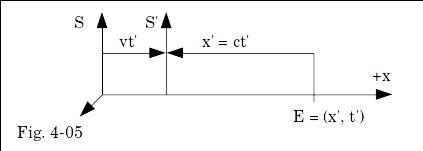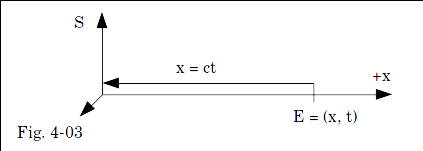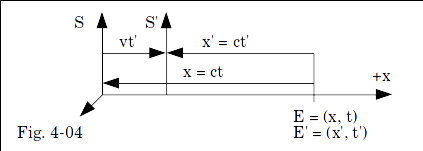

Jan Slowak
Senior Members-
Posts
79 -
Joined
-
Last visited
Content Type
Profiles
Forums
Events
Everything posted by Jan Slowak
-
I really want to understand how Lorentz Transformations come about! I have analyzed the derivation of Lorentz Transformations (LT) in [3] The special and general theory of relativity; Albert Einstein; The first part; About the special theory of relativity; 2006; swedish [7] Modern Physics; Second edition; Randy Harris; Chapter 2; Special Relativity; 2008 I believe that the derivation in these two books is not self-consistent. Why? I explain below and would like help with this. Both in [3] and [7] one uses three special cases to derive LT. You start from two linear equations (I use my own notations to more easily refer to different parts of the derivation): LEx': x' = Ax + Bt LEt': t' = Cx + Dt To determine the constants A, B, C, D, three special cases are used: SC1: x' = 0, x = vt SC2: x = 0, x' = -vt' SC3: x' = ct', x = ct We look at the first one that I depict in Fig. SC1. SC1: x' = 0, x = vt My comment: At the time (t' > 0), an event occurs in the S'-origo (x' = 0). The literature states that the distance between S and S' is x = vt. I think this is wrong: It should be x = vt'. Why? S has no knowledge that the event occurred and where somewhere it happened! S' instead knows that the event occurred when its clock showed time t'. Then S' can definitely say that the distance between S and S' is vt'!
-

Topic 4: Special Relativity - Lorentz transformations
Jan Slowak replied to Jan Slowak's topic in Relativity
I do not want such discussions. I wrote at the beginning of this thread: I really want to understand how Lorentz Transformations work! I think I do not make a mistake in Fig. 4-06b, Fig. 4-07b. If you think I'm wrong then I want an explanation! Specifically, no deviation from the main subject. So: Where are the errors I make in the pictures Fig. 4-06b, Fig. 4-07b and how I describe the phenomenon? -

Topic 4: Special Relativity - Lorentz transformations
Jan Slowak replied to Jan Slowak's topic in Relativity
I can also write in the same way as you: Note: you are obviously wrong, you just need to learn to accept that and then understand why. What are you doing? But I do not want to engage in such discussions. I wanted to talk about the derivation of Lorentz Transformations. -

Topic 4: Special Relativity - Lorentz transformations
Jan Slowak replied to Jan Slowak's topic in Relativity
Where are the errors I make in the pictures Fig. 4-06b, Fig. 4-07b and how I describe the phenomenon? I do not ignore what you write. I read everything and think and answer. Refer to the pictures Fig. 4-06b, Fig. 4-07b and say where am I wrong. -

Topic 4: Special Relativity - Lorentz transformations
Jan Slowak replied to Jan Slowak's topic in Relativity
Where are the errors I make in the pictures Fig. 4-06b, Fig. 4-07b and how I describe the phenomenon? -

Topic 4: Special Relativity - Lorentz transformations
Jan Slowak replied to Jan Slowak's topic in Relativity
Thanks. I've watched the video before. So you cannot prove that I am wrong in the pictures Fig. 4-06, Fig. 4-07! -

Topic 4: Special Relativity - Lorentz transformations
Jan Slowak replied to Jan Slowak's topic in Relativity
You jump between different pictures and do not logically follow our disclaimer. An event is denoted by E = (x, t) for S and E'= (x', t') for S'. In Fig. 4-05, it should be E '= (x', t '). But don't forget that E is identical to E '. Where are the errors I make in the pictures Fig. 4-06, Fig. 4-07 and how I describe the phenomenon? -

Topic 4: Special Relativity - Lorentz transformations
Jan Slowak replied to Jan Slowak's topic in Relativity
If you mean your question At the same time in whose frame? then my answer is as follows: in S, this should be obvious. I write in my explanation of the picture Fig. 4-05: At the same time, an event, a light signal, occurs in the point Px. Px is in the reference system S (x refers to S, x' refers to S'). Once again: we talk about the pictures Fig. 4-06 and 4-07 (or Fig. 4-06b and 4-07b, in these are also S depicted). Can you be more specific and write what are the errors I do? What is incompatible with the first postulate? -

Topic 4: Special Relativity - Lorentz transformations
Jan Slowak replied to Jan Slowak's topic in Relativity
From Wikipedia: 1) The special theory of relativity postulates that the speed of light in vacuum is constant equal to c for all observers in uniform relative motion. 2) All systems, where observers move at a constant speed, inertial systems, are equivalent and therefore the laws of physics must give the same results for all of them. I didn't want to complicate pictures unnecessarily. But in my description of Figs. 4-06 and 4-07 one could read what applies to S' and what applies to S. I attach copies of these two pictures where I draw S in the point P0. -

Topic 4: Special Relativity - Lorentz transformations
Jan Slowak replied to Jan Slowak's topic in Relativity
Fig. 4-06, Fig. 4-07: When S' in its motion is in the S-origo, when t = t' = 0, then the event in S arises at a distance x from the S-origo. You can use the same postulates used in the literature: [3] The special and general theory of relativity; Albert Einstein; The first part; About the special theory of relativity; 2006; swedish [7] Modern Physics; Second edition; Randy Harris; Chapter 2; Special Relativity; 2008 Fig. 4-06, Fig. 4-07: Can you be more specific and write what are the errors I do? Please check my answers to Ghideon and swansont. -

Topic 4: Special Relativity - Lorentz transformations
Jan Slowak replied to Jan Slowak's topic in Relativity
I do not mix with reference systems. I use them in the same way as in [3] The special and general theory of relativity; Albert Einstein; The first part; About the special theory of relativity; 2006; swedish [7] Modern Physics; Second edition; Randy Harris; Chapter 2; Special Relativity; 2008 You make measurements in a reference system and equate the result with the variable from the other. For example: x = Ax' + Bt'; LTx': x' = (x – vt)γ; LTt': t' = (t – vx/c2)γ What is the problem? Where are the errors I make in the pictures Fig. 4-06, Fig. 4-07 and how I describe the phenomenon? We have only one reality, but each of the observers expresses and describes their measurements with their own variables. We have an event somewhere on the x-axis of S. S denotes the event with E = (x, t). S' denotes the event with E' = (x', t'). But for both reference systems, it's all about one and the same event! What is the problem with this? I ask you the same question that I asked to swansont. Where are the errors I make in the pictures Fig. 4-06, Fig. 4-07 and how I describe the phenomenon? Be specific, please. -

Topic 4: Special Relativity - Lorentz transformations
Jan Slowak replied to Jan Slowak's topic in Relativity
It is not a similar problem, but it is exactly the same problem with clearer explanations and pictures. I was going to help Ghideon move on. The sum of the two lengths for S' is vt' + ct' and it is the same length as x in S. We have two reference systems but we have only one reality! -

Topic 4: Special Relativity - Lorentz transformations
Jan Slowak replied to Jan Slowak's topic in Relativity
Another explanation for the same phenomenon. A reference system S' moves on the x-axis to the right at a constant speed v > 0. When S' passes the point P0, its clock is reset, t' = 0. At the same time, an event, a light signal, occurs in the point Px. Px is at a distance x from the point P0. While the light signal moves towards S', S' moves to the right. When the light signal reaches S', two distances occur on the x-axis. Distance [P0, S'] and distance [S', Px]. The length of these two distances is: Distance [P0, S'] = vt' Distance [S', Px] = ct' Then we have the following relationship: x = vt'+ ct'. Is this right? -

Topic 4: Special Relativity - Lorentz transformations
Jan Slowak replied to Jan Slowak's topic in Relativity
When I describe a physical phenomenon, make a mathematical model of it, presents my ideas, arguments, then I do not want to deviate from the main track. It's not possible! I present something, ask if I am right or wrong, then I want either an approval, Yes, or a No, but then you have to counter-argument. It should not be more difficult than that!- 61 replies
-
-1
-

Topic 4: Special Relativity - Lorentz transformations
Jan Slowak replied to Jan Slowak's topic in Relativity
This is no answer. If you answer NO, you must counter-argument. -

Topic 4: Special Relativity - Lorentz transformations
Jan Slowak replied to Jan Slowak's topic in Relativity
I analyze and talk about the derivation of LT. We don't have them yet! You cannot use them as counter-arguments. Please, do not send other pictures. We talk about my picture Fig. 4-05. -

Topic 4: Special Relativity - Lorentz transformations
Jan Slowak replied to Jan Slowak's topic in Relativity
Is there no one who wants to go through this thread and either confirm or argue against Fig. 4-05? -

Topic 4: Special Relativity - Lorentz transformations
Jan Slowak replied to Jan Slowak's topic in Relativity
This is not true! In the figure Fig. 4-03, we have processed and calculated the coordinates of the event in S. In the picture Fig. 4-04, we have processed and calculated the coordinates of the event in S'. I draw a new picture only with the components for S', see Fig. 4-05. This applies: during the same time t' as the light signal reaches S', the S' moves a distance vt'. S' knows that it moves at speed v > 0. S' registers the light signal at time t'. Then S' knows that it is from S at a distance equal to vt'. Is not it like that? -

Topic 4: Special Relativity - Lorentz transformations
Jan Slowak replied to Jan Slowak's topic in Relativity
I thought the same way as Bufofrog. We look at the picture Fig. 4-03. If we believe that t = 0 when the event occurred at point x, then t = x/c, time when S gets to know that the event occurred. Then E = (x, x/c). I would also like to point out that we cannot say much about the event unless you know the distance to it. Now we move on and also add the second reference system S' which moves to the right at constant speed v > 0. When the time is t = 0, t' = 0, both reference systems are located in the same point. Then, an event at distance x from the S-origo (S'-origo) occurs. See picture Fig. 4-04. What is special about S' is that while the light signal fails the distance x', S' moves the distance vt'. Am I right here? -

Topic 4: Special Relativity - Lorentz transformations
Jan Slowak replied to Jan Slowak's topic in Relativity
Maybe I was unclear. We look at Fig. 4-01. I am sure that x from E = (x, t) means the distance between the S-origo and the point on the x-axis where the event occurred, the point x. But what does t from E = (x, t) represent? What time do you mean here? We must also ask ourselves the question: How does S know that the event E has occurred? -
I really want to understand how Lorentz Transformations work! I refer to the picture Fig. 4-01: There we have an inertial reference system, S, that I depict with the axes x, y, x. In the future, we will only process the points on the x-axis, so in the next pictures I will draw only the x-axis. We regard this reference system as stationary, ie the distance between the reference system origin and the point where the event occurs is the same all the time. Then I would like help with defining what the coordinates x, t mean for S.
-
I summarize once again my main idea in this thread: Special Relativity, SR: Lorentz Transformations, LT: LTx': x' = (x – vt)γ LTt': t' = (t – vx/c2)γ where γ = 1/(1-v2/c2)1/2 is called the Lorentz factor, LF. Time dilation, TD: t' = tγ In these two parts of SR there are two inertial reference systems S, S' and one event E = (x, t), E' = (x', t'). It is the same event with the different designation for S and S'. Now we follow the derivation of LT in [7] Modern Physics; Second edition; Randy Harris; Chapter 2; Special Relativity; 2008 You start with two linear equations: LEx': x' = Ax + Bt LEt': t' = Cx +Dt In the derivation of LT in [7], three special cases are used to determine the constants A, B, C, D. These three special cases SC1: x' = 0, x = vt SC2: x' = -vt', x = 0 SC3: x' = ct', x = ct are conditions that apply to LEx', LEt': Then: {LEx' and LEt' and SC1} and {LEx' and LEt' and SC2} and {LEx' and LEt' and SC3} → B = −Av, C = −A v/c2, D = A, A = γ → LTx': x' = (x – vt)γ LTt': t' = (t – vx/c2)γ If the derivation in [7] leads to LT and LT leads to the formula for time dilation then we must NOT have any contradiction during the verification of the derivation of LT. {LEx' and LEt' and SC1} is part of the derivation. Its verification LTt': t' = (t – vx/c2)γ SC1: x' = 0, x = vt → t' = (t-v(vt)/c2)γ → t' = t(1-v2/c2)γ → t'= t/γ must NOT lead to contradiction! But it does! This shows that the derivation of LT in [7] is not self-consistent!
-
You write” The problem is that you swapped the frames” and ” In your LT derivation”: You forget that it is not my derivations of LT. So if you say I'm wrong, I'm right! In my work I show that the derivation of LT in [7] led to nonsense.
- 41 replies
-
-1
-
LT and the formula for time dilation apply to all pairs of points ((x ', t'), (x, t)}, which verify the LT, of course. Do we have a different formula for time dilation for each point where you see a lamp blinking?
-
I have never said that anyone should accept my conclusions in my work. In this thread, I show a mathematical evidence that LT is non-self-consistent. If you do not have counter-arguments, disproof, refrain from commenting. Mathematics is the queen of science! There is no mix of coordinate systems (frames) in this thread. It's about pure mathematics! You say I'll show something myself! In this thread, I show a mathematical evidence that LT is non-self-consistent.



















